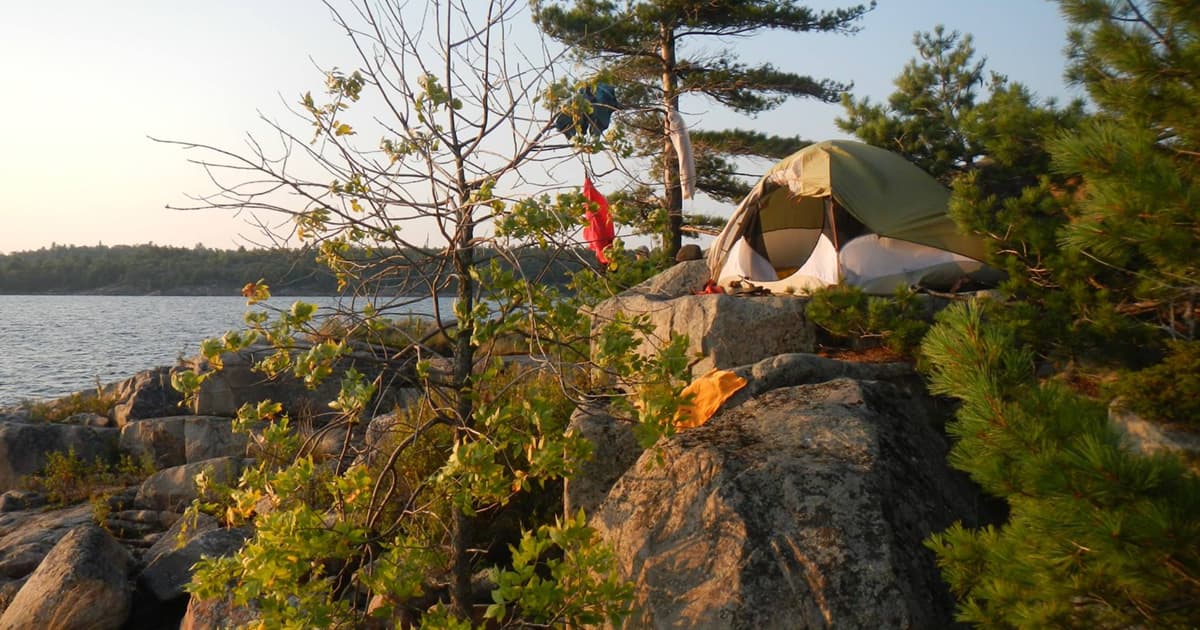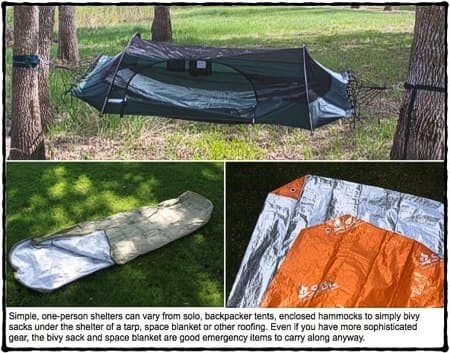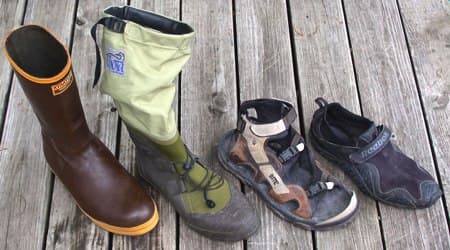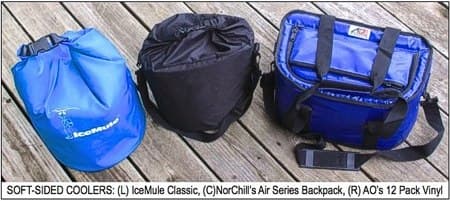A Kayaker's Camping Checklist

Some of my most memorable kayaking trips were those solo overnights or weekend adventures where I packed up the boat with camping gear and pushed off from shore, destine for a nearby bay or secluded island beyond the city lights. Prepping for such a trip was pretty much second nature as far as basic gear went - it was my adventuring agenda (wildlife viewing, fishing or simply the desire to just get away from it all) - that determined what I would take and what I would leave behind.
I find it easiest to prepare and pack for a solo camping trip by going through a camping checklist on two levels: my primary gear (boat, paddle, clothing, etc.) and a secondary list if I've decided I want a special experience (a tripod for photography, or extra cooking gear if I want to really get into outdoor cuisine).
Camping with a kayak means you can take more gear than you could fit into a backpack for a land-based experience, yet space and weight limitations do put an upper limit on what you can ultimately carry. In the case of my yearning to prepare some fancy meals over a shoreside campfire, I might splurge and bring a Dutch oven with me. If, however, I want to travel light so I can take extra camera gear, a small backpack cook kit might serve me just as well.
Here then is an overview check list of options to consider bringing on your own kayak camping trip:
KAYAK
Seems obvious, but the type of boat you have (recreational kayak or touring, for example) means you have to anticipate challenges along your route. Will you face long stretches of open water in adverse conditions? If so, you might want to carefully select where you will overnight and what factors might affect whether you can paddle back or wait out the weather and sea conditions. In either case, think ahead about your options; can your skills and your boat's performance characteristics handle it?
KAYAK ACCESSORIES
Important to have handy as part of any on-water venturing, but particularly critical on distant/overnight jaunts, are these important utility/maintenance items:
- PFD (This should be forever/always engraved in your mental checklist!)
- Spare paddle
- Bow line - for tying off boat no matter how far up the shoreline you can park it
- Paddle Float/rescue gear (and have practiced using it!)
- Bilge pump/bailer or sponge
- Running light/deck light
- Cockpit cover - stow gear in kayak at night and cover to keep dry; critters out
- Repair kit with tools/materials to fix breaches in hull (quick-set resins, patches), broken rudder/pedal mechanisms; (a multi-purpose tool is an invaluable "toolbox")
- Mini tools for adjusting/fixing any camp/cooking appliances (stove, lantern, etc.)
- Spare clips, cleats, section of bungee cord, parachute cord
- Sewing kit (stout thread can be used to temporarily fix things when glue or tape doesn't work)
- DUCT TAPE! It goes without saying...
50 years of lightweight, maneuverable, high-performing kayaks.
Check out this interview with Tom Keane, Eddyline Kayaks Co-Owner, on their journey!
TENT/SHELTER
There are numerous 1-2 person tents on the market. While shape/design is important, the critical factors in selecting a reliable tent are:
- tent fly that extends down entire wall of tent;
- built in 'bathtub' floor and ground tarp (under tent or inside);
- minimal and repair/replacable tent hardware (poles, lines, stakes);
- bug screen for 'bugs' and ventilation.
If you want to really go minimalist, it's sometimes an adventure to skip the tent and rely on your primitive skills with a tarp/lean-to shelter or perhaps a camping hammock or even just a bivy bag.

SLEEP SYSTEM
A comforting, replenishing rest is an important factor on any outing. A good three-season sleeping bag, rated down to about 10 degrees below the lowest temperatures realistically expected, should serve a kayak camper well. You may also want to consider a bag liner - either to add a few degrees of warmth or as a cool, lightweight shell for sleeping in warmer conditions.
Several factors to consider when choosing the proper bag include:
- moisture-proof insulation;
- head/foot venting;
- a good sleeping pad (with cushioning and insulating qualities);
- pocket or straps to secure your pad.
CLOTHING
Basically, clothing is a sequence of layers that shelter your body from the elements and help regulate your body's temperature and moisture levels. Climate, season, terrain, physical activity and your own body metabolism all factor towards what specific choices in apparel you should be wearing throughout your paddling venture.
Clothing is one of our most essential pieces of gear - should an emergency situation arise and all you can do is sit down and wait, at least be able to do it in protective and tolerable comfort!
As a boy scout I learned to choose the right clothing to bring camping by starting at my feet and working up my body - a mental checklist of everything I'd need/want to wear while camping. It worked then; it works now!
FOOTWEAR
Even if you're sitting on your butt - all day in the cockpit, all evening by the campfire - proper footwear can make/break any outdoor experience.
For kayakers wanting to minimize on gear, footwear that works as both in and out of the water is a big advantage. A good water shoe should be flexible enough to work your foot inside the cockpit yet have a strong enough sole for rocky beaches. Oftentimes it's nice to have a "camp shoe" to wear around the fire and if it also provides good sole/and ankle support, it can be worn for short treks along shore or other forays beyond the campsite.

"Cannery boots" are the standard dress code for most ocean kayakers I know, especially along the Pacific coast. In the warmer temperate/tropic regions, a good sandal serves myriad functions in a variety of areas.
Check for proper fit including ample toe room, heel holding form, ankle support, a reliable fastening/lacing system and a proper tread for needed traction on slippery shorelines or hiking rough trails.
STOCKINGS/SOCKS
Thin, synthetic socks work well for providing a little extra warmth and can also make it easier to slip your wet foot into/out of an equally wet or tight boot or shoe. Of course, for around camp, sleeping or lining a heavier hiking shoe/boot, nothing works better than a wool sock. One hundred percent wool or a blend, you should have at least two pair along. They also make a good emergency mitten if your hands get cold.
PANTS
Again, weather conditions may dictate whether you want to wear full-length paddling pants or shorts while in the cockpit (although you should ultimately "dress for the water, not the air"). On shore, shorts are generally cooler, while pants protect from the sun and insects. Paddling pants/rain pants can be very hot but also work as a lower body wind-breaker. Generally, the better the quality, the higher the wear and tear factor.
On-land pants/shorts should be fast drying and to some extent either repel water or minimize it's absorption. Cotton clothing is not usually a good choice, especially with all the techy synthetic fibers and processes on the market - save the cotton for the tropics.
UNDERGARMENTS
As a good base layer, undergarments draw perspiration away from our skin and can also trap warm air to insulate us from the cold. Cotton/synthetics are probably the most common material used in both men's and women's underwear. Bring several changes; Like sox, they are easy to wash in camp, but still pack several changes.
A pair of long-johns can be used to take the chill off and also make for good "pajamas" inside the sleeping bag. It's not a good idea to sleep in the clothes you've been wearing all day - you're introducing perspiration and dirt into your sleeping bag.
SHIRTS/TORSO
Long or short sleeves? Choose synthetics over cotton; long sleeves and light colors in bug country. Your upper body makes the most of layering, from the base water-wicking undergarment through the thermo insulating mid layers to the element-protecting outer shell.
An important function of all upper body clothing is it's ability to breathe! A good ventilation system also optimizes any advantages a particular material or design may have. Synthetics rule as the fabrics of choice - and choices there are plenty! There's a plethora of techno-fibers out there - best to ask around and see what works for your paddling buddies.
HANDS AND HEAD
Gloves and hats, of course. Paddling gloves for dry, warm and raw-worn hands protection while on the water; gloves/liners for warmth on land. Consider a work glove if you expect to do a lot of camp chores (firewood processing, building, etc.).
Headgear comes in handy for several uses:
- Brimmed hats for shade and/or rain; (get one with chinstrap or retainer cord)
- Stocking cap for warmth (during the day or while sleeping)
- Full head covering insect screen in bug country
- Sun glasses (and an eyeglasses lanyard/retainer cord)
- Bandana
FOOD
If you've done any kind of camping before you probably already have your foods/snacks of choice you bring along. Importance here is to keep it fresh and well sealed, too. Generally food for camping is packaged two ways: all foods for a particular meal (breakfasts, etc.) are coded (same colored containers, for example); or all the food for each day's entire menu is packaged as such. Either way, consider one-pot meals, minimal utensil/pot needs and any foods that can be easily prepared and/or modified.
Soft-sided coolers keep food as cold as rigid boxes do, but are more easily stowed through hatches, and fit in weird spaces below deck where a rigid cooler wouldn't. And, If you winter kayak camp, a cooler can also be used to keep food from freezing.

WATER
It's especially important to avoid dehydration, and critical to discipline yourself to drink ample amounts of water (replenish before you actually feel thirsty). When boiled, it's also the primary "ingredient" in much camp cuisine. Finding fresh water, unless collected during rains, usually means processing water found in nature (and presumed contaminated regardless of how pure it may seem). A reliable water filter is essential for providing healthy water.
If you decide to carry water with you (a least a gallon per day - at 8 pounds per gallon!), you may have to jettison other gear to make room and stay within trim weight. Flexible/collapsible containers can be "molded" to fit almost anywhere throughout their emptying process). Water bottles stashed throughout your boat (at least one or two easily accessible on deck) and/or perhaps a backpack hydration system are all good methods of having drinking water available throughout your camping trip.
PERSONAL HYGIENE
Yes, there's always leaves! Not really! Besides, there are some things that are even more important than "essentials", and TP is one of them in my book. From a health aspect (if not a social one), other hygiene items include toothbrush & paste/soap/deoderant and other toiletries as you need or desire. Be advised that scented soaps and lotions could attract pests. And please think biodegradable!
OTHER ESSENTIALS
Each of the following pieces/units of gear should be compiled and selected based upon your particular needs and other gear matings. Remember, the more gear you have that is dependent upon other gear, the more that can go wrong:
- First Aid Kit - Stylized for the environment and activities if possible. Don't forget medications (include dosages - for others to know, just in case…) and sunscreen
- Batteries - bring enough for each different piece of equipment, also consider solar/heat re-charging units
- Emergency radio or beacon with signalling, weather, location, communication options
- Emergency capsize/survival pack; (be sure to include a compass, whistle, fire starter, knife)
- Charts or maps of general area in case you need to alter pre-planned routes;
- File a Float Plan before embarking
- Quality steel, 4"+ fixed-blade knife
- Camp saw/hatchet - each has its limitation/a good knife is usually more versatile
- Flash light/head lamp (some new solar-powered lanterns are ideal as camp lights)
- Camera (waterproof or in waterproof case); binoculars (same protection)
- Fishing gear (breakdown rod, reel, assortment of lures in small, stow-on-deck tackle box)
- Books; journals and other personal luxuries
These tips are suggestions, and I am sure I've forgotten a few items - but that's up to you to figure out for your own personal needs and pleasures. Picking and choosing among these and other options lets you customize your kayak camping experience for your own enjoyment.
COOKING/EATING UTENSILS
Most camp cook kits employ a stacking system that places everything inside a pan that can vary from a high volume Dutch oven style of pot down to a small quart-size pan for boiling water. They usually at least also include small containers/cups. Some kits have a multi-purpose pot that works as a frying pan, too. If you have room, you can always add a small skillet to your mini pot kit.

Some kits provide breakdown or combo utensils. Most of these kits now also come with a case that doubles as a water carrier/dish washing 'sink'. With such options it's easy to find one that suits your cooking/eating style best.
A good sharp knife for dicing and slicing; a spoon for mixing, stirring, consuming and maybe a spatula/flipper for maneuvering food around a pan is about all you really need for utensils. Some kits provide breakdown or combo utensils while a few offer a 'spork' (spoon/fork combined into one implement). Personally if I can't eat it with a spoon and knife (to stab and jab) I don't cook it.
Other items are just handy or a bonus when wanting to splurge and enjoy extended gourmet cooking while camping. The easiest kit is one that you simply put together yourself. There are kitchen kits available; they do tend to be spendy and perhaps offer a few frilly items you don't really need. If you are new to camp cooking you may want to get one and weed out those tools you find don't need to tag along.
Remember to bring salt, pepper and other tasty spices and herbs you enjoy, too. Tea bags and other dry-mix drinks are easy to pack for a tasty alternative to drinking plain water all day long. Any small, water/air tight container works for packaging up your own special taste kit.
The following items make for a well-rounded camp kitchen, from group cooking to selected items geared towards solo meals:
- Camp stove (compact to large capacity burner)
- fuel (propane, butane, wood and other burnables)
- matches, sparker-igniter (in waterproof container)
- Dutch oven style pot/with lid (10"-12" cast aluminum works well)
- Large pot or coffee pot/with lid for base supply of hot water (drinking, cooking, washing - keep it warm/hot near the fire throughout the stay in camp);
- Small pot(s)/with lid for preparing dishes
- Bowls (larger for main meals; smaller for side dishes, beverages)
- cups for hot/cold beverage (bowls/cups with tight lids can be used to bring food along for later snacking while enroute)
- large spoon for mixing, stirring, eating
- knife for food prep or eating
- OK, a "spork" or other combo utensil
- small spatula/flipper
- can opener or any other specialty tool you might need based on the menu you've created (a cork screw on your Swiss Army Knife is priceless!)
- Biodegradable soap, dish cloth/sponge or scrubber pad for cleaning gear
Here are even MORE TIPS & SUGGESTIONS for making the most of a kayak camping adventure:
|
Be Safe, Have fun out there!
Tom Watson is an avid sea kayaker and freelance writer with 15 years experience in the North Pacific waters of Kodiak Island, Alaska. He is also a freelance writer whose articles have appeared in most of the popular kayaking publications. He posts articles, thoughts and paddling tips on his website: tomoutdoors.com He has written 2 books, "Kids Gone Paddlin" and "How to Think Like A Survivor" that are available on Amazon.
Related Articles
This question is from imsealin – they asked how long should a kayak be for sea kayaking, and can it be…
One of the considerations for deciding which type of material you want your kayak to be made from…
I've been busy lately rearranging my cooking essentials: the little tools that I can't do without. Of…
In 1971, I outfitted and guided three wealthy Chicago men--the least affluent of which earned a quarter…




